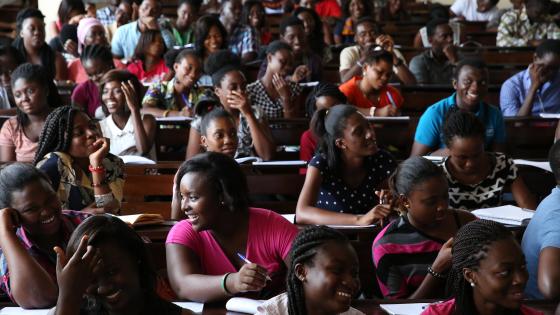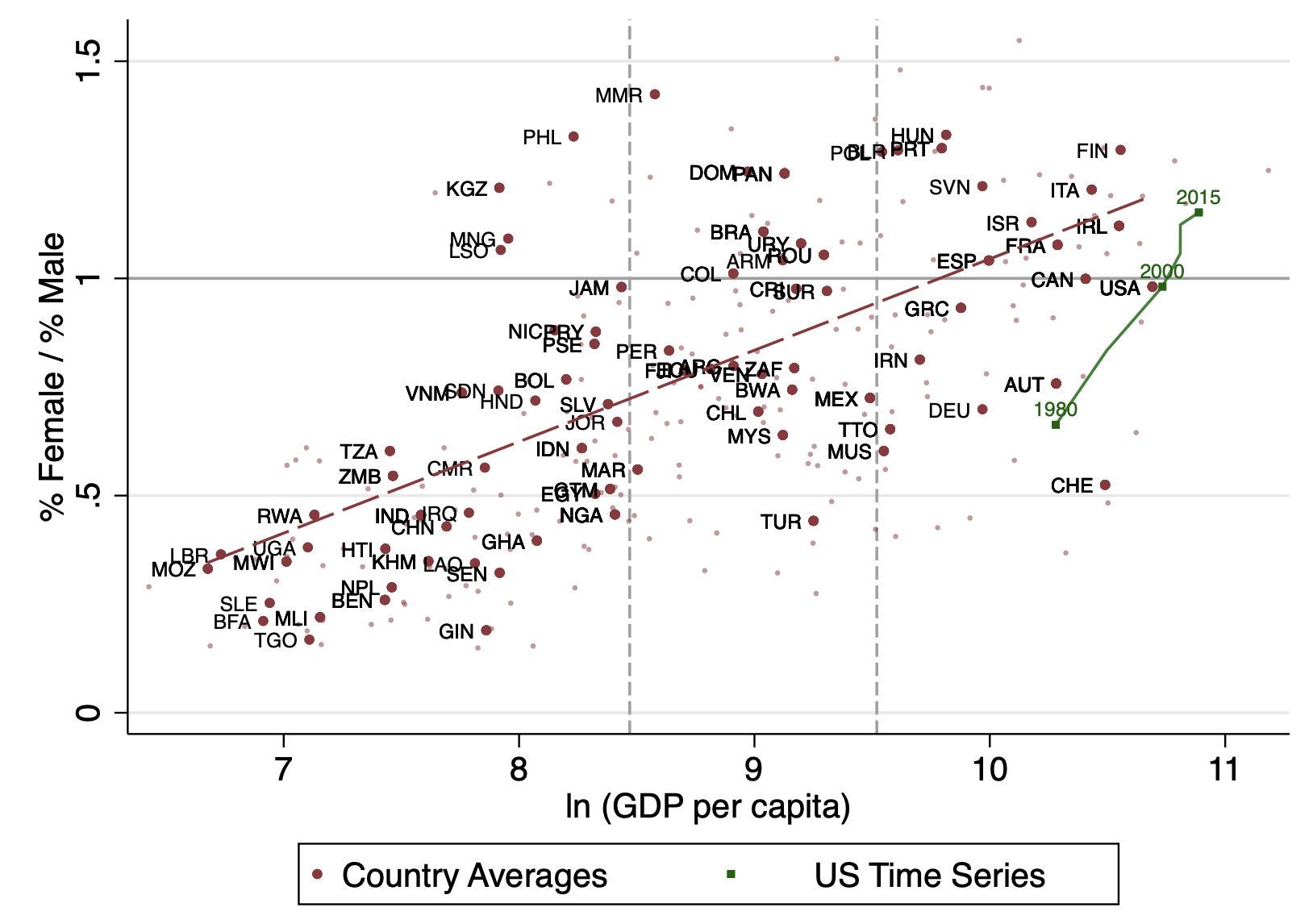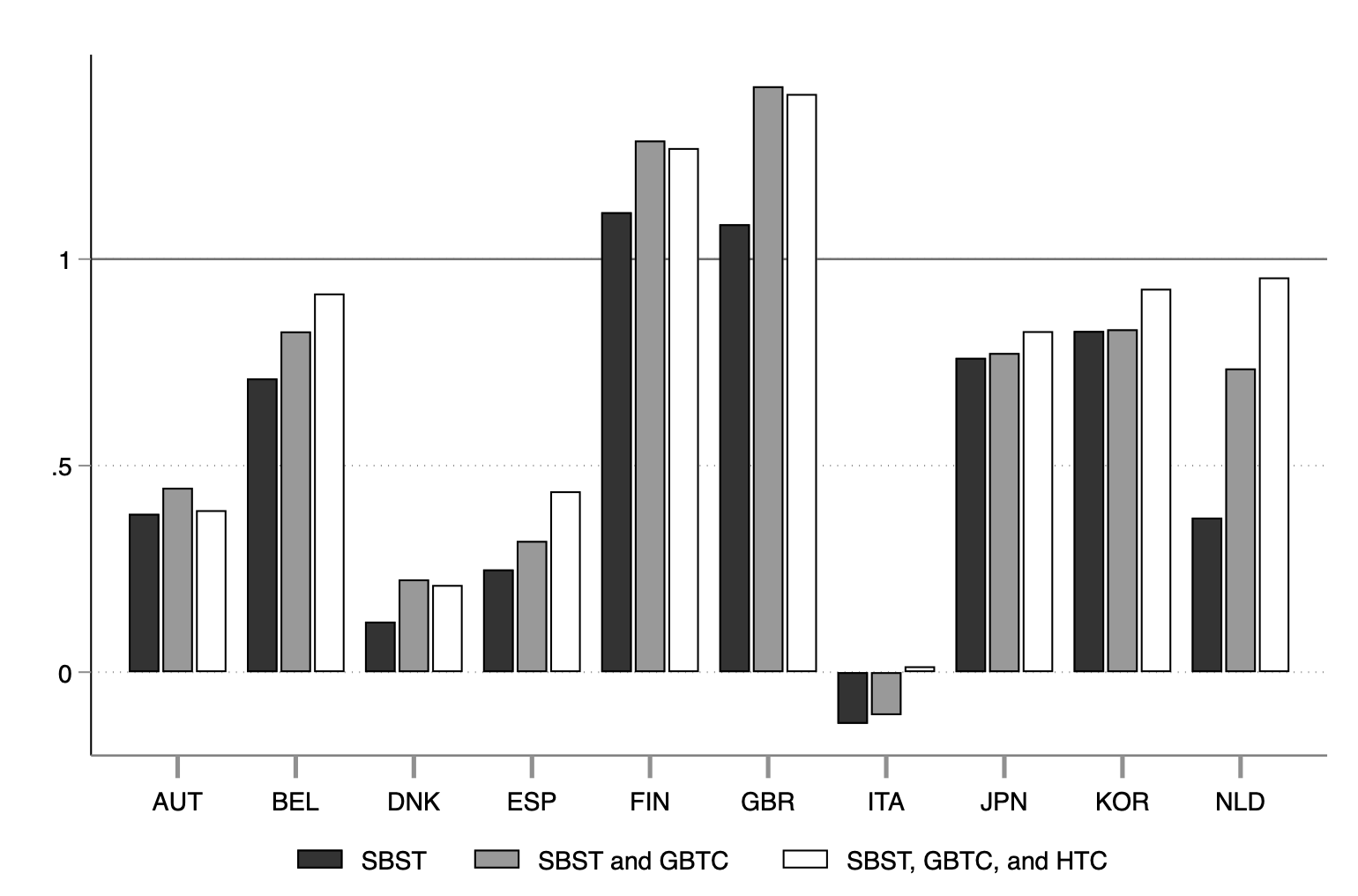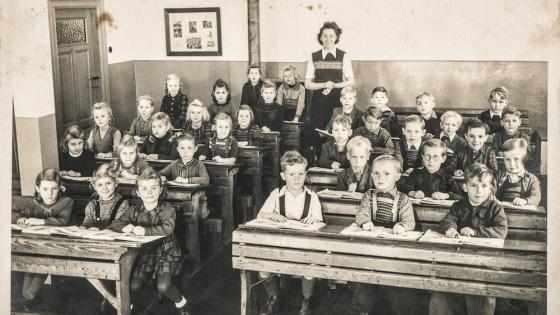Among 25- to 34-year-olds today, women in all 38 OECD countries are more likely to hold tertiary degrees than men (Wolfers 2021). Likewise, Grant and Behrman (2010) find that, in some less developed countries, female students progress at the same pace as or faster than their male peers conditional on enrollment, but nevertheless the gender gap remains. In our research (Feng et al. 2023), we highlight that women in low-income countries are only half as likely to have tertiary or secondary degrees as men.
Change in the education gender gap across time and countries
Figure 1 plots the gender gaps in university completion against log GDP per capita across countries and in the US over time. This graph underscores a significant disparity in the poorest economies, where the likelihood of obtaining a college degree for women is only 20 -30% that of men. Impressively, this gender education gap narrows quickly with development levels and reverses in richer economies, where women are more likely than men to have a college degree. These global trends align with US time series data: the gender gap, which was substantial in 1980, gradually diminishes over time, achieving parity in the 2000s before reversing.
Figure 1 Gender gaps in education
Note: This figure plots the female-to-male population shares of completing university against log GDP per capita for each country-year sample (light red dot) and country averages (dark red dot). The red line represents the linear fit of country averages. Green data points show the US time trend.
We find similar evidence when investigating the evolution of the gender education gap across birth-year cohorts for countries across different income levels. In middle- and high-income economies, gender education gaps start to reverse for cohorts born in the 1970s and 1960s, respectively. Unfortunately, low-income countries still lag far behind. In low-income countries, the gender education gap does narrow, but even for cohorts born in the 1990s, females are only about 60% as likely as males to complete college or secondary school education.
Reducing education gender gaps increases female empowerment
The importance of studying gender gaps in education lies in its association with female empowerment, contributing to more equitable and positive gender outcomes. Research by Lise and Seitz (2011) demonstrates that increasing women's education levels reduces consumption inequality within households. Likewise, Doepke and Tertilt (2018) show that the desired fertility of higher-educated women has a larger impact on realised fertility compared to that of less-educated women. However, to this date, not only have we been lacking systematic comparisons of gender gaps in educational attainment between rich and poor countries, but also systematic analyses of the forces that are driving these gaps. Thus far, existing studies have linked women's rising education rates to various disparate factors such as fertility behaviors (Rios-Rull and Sanchez-Marcos 2002), divorce risks (Guvenen and Rendall 2015), technical change favoring women (Rendall 2018), and women's formal working hours (Reimers 2020). Evidence suggests that structural transformation, gender-biased technical change, home technological improvements, and shifts in the marriage market are strong drivers in improving female labour-market outcomes with economic development (e.g. Cerina et al. 2021, Greenwood et al. 2016, Heathcote et al. 2010, Ngai and Petrongolo 2017). Consequently, a first natural step is to explore whether and how much these drivers can account for the narrowing and reversal of the gender education gap during development.
By what mechanisms does the gender education gap close?
Our research fills this gap in the literature by systematically investigating the contribution of four mechanisms to the closing and reversing gender education gaps:
- Skill-biased structural change: This involves simultaneous structural transformation and skill-biased technological change as in Buera et al. (2021). It leads to a rise in skilled services in which women have a comparative advantage, amplifying the demand for educated women in the labour market.
- Gender-biased technological change: This could signify either technological advancements or a reduction in gender-based discrimination, leading to improved labour market opportunities for women.
- Home technological changes: Because home production is the inherent trade-off against working in the market, home technological change affects women's labour supply and educational decisions.
- Changing marriage market: The educational assortative matching process plays a role in motivating women to pursue education even when working hours are low, owing to the skewed probabilities of matching with similarly educated men.
To formalise these ideas, we develop a structural model that replicates the overall trend of narrowing and reversing gender education gaps across varying levels of economic development. By conducting counterfactual analyses with the parameterised model, we gain clearer insights into how each mechanism contributes to the reversal of the gender education gap, both over time in the US and across different countries.
Our analysis sheds light on the pivotal role of skill-biased structural transformation in explaining the widespread narrowing of the gender education gap. While skill-biased technological change alone offers some explanatory power for closing the gap in the US, it inadvertently leads to decreased labour force participation rates for both educated and uneducated women, contradicting empirical evidence. This discrepancy arises due to men's comparative advantage in sectors like manufacturing and agriculture, where skill-biased technological change dampens women's incentive to pursue education and enter the labour market. Consequently, skill-biased technological change in these sectors even exacerbates the gender education gap, counteracting the positive effects seen in the service sector.
On the other hand, structural transformation alone accounts for more than half of the closing gap in the US – yet falls short of achieving a complete reversal. Structural transformation encourages women's labour market participation, driven by the increasing opportunity cost of remaining at home as the service sector expands. This shift affects both educated and uneducated women. Thus, a crucial finding emerges: skill-biased technological change, especially within the service sector, and structural transformation must synergise to effectively narrow and ultimately reverse the gender education gap. In contrast, other mechanisms exert a comparatively minor quantitative influence on the gap. Similar insights hold when comparing countries across varying income levels.
Examining the contribution of inequality-reducing mechanisms in high-income countries
We can also quantify the contribution of the first three mechanisms (the data on the changing marriage market is not available) across a set of high-income countries between 1980 and 2005. Figure 2 illustrates, for each country, the share of the gender education gap explained by three counterfactual cases: one considering only skill-biased technological change and structural transformation, an alternative case additionally allowing for gender-biased technological change, and a third case further incorporating home technological changes. Notably, skill-biased structural transformation helps explain the evolution in half of the countries, including Finland, the UK, Belgium, Japan, Korea, with an average explanatory power of 90% . The second and third sets of columns present the effect of first adding country-specific gender-biased technological change and further adding home technological changes, respectively. The addition of country-specific gender-biased technological change and home technological changes yields smaller effects on narrowing gender education gaps, except for the Netherlands. Intriguingly, the proposed mechanisms collectively explain less than half of the observed patterns in Denmark, Spain, and Italy. In these cases, additional mechanisms—like evolving social norms or context-specific policies and reforms—likely contribute to the gradual reduction of the gender education gap over time.
Figure 2 Share of the change in the gender education gap explained by different mechanisms
Notes: This figure plots the share of the gender education gap in each available country that is explained by: i) a counterfactual with only skill-biased technological change (SBTC) and structural transformation (ST), ii) an alternative case additionally allowing for gender-biased technological change (GBTC), and iii) another alternative case additionally allowing both for GBTC and home technological changes (HTC).
Conclusion
To sum up, our research starts by unveiling a strong negative relationship between income and gender education gaps, a phenomenon that persists despite widely varying gender norms across countries. Furthermore, we underscore the critical role of shifts in the demand for educated women in driving the reversal of the gender education gap during economic development. These patterns hold true even in the absence of specific government policies. Policymakers concerned about women's participation and education can adopt a non-gender-specific approach by fostering the growth of the skilled service sector, where women have comparative advantages. Such policies can create an enabling environment for women's education and workforce participation, effectively narrowing the gender gap and fostering greater gender equality through demand effects.
References
Buera, F J, J P Kaboski, R Rogerson and J Vizcaino (2021), “Skill-Biased Structural Change,” The Review of Economic Studies 89:592–625.
Cerina, F, A Moro and M Rendall (2021), "The role of gender in employment polarization," International Economic Review 62(4):1655-1691.
Grant, M J and J R Behrman (2010), “Gender gaps in educational attainment in less developed countries,” Population and development review 36: 71–89.
Feng, Y, J Ren and M Rendall (2023), “The Reversal of the Gender Education Gap with Economic Development,” Working Paper.
Greenwood, J, N Guner, G Kocharkov, and C Santos (2016): "Technology and the Changing Family: A Unified Model of Marriage, Divorce, Educational Attainment, and Married Female Labor-Force Participation," American Economic Journal: Macroeconomics 8 (1): 1-41.
Guvenen, F and M Rendall (2015), “Women’s emancipation through education: A macroeconomic analysis,” Review of Economic Dynamics 18: 931–956.
Heathcote, J, K Storesletten and G L Violante (2010), "The macroeconomic implications of rising wage inequality in the United States," Journal of Political Economy 118. (4): 681-722.
Ngai, L R and B Petrongolo (2017), "Gender gaps and the rise of the service economy," American Economic Journal: Macroeconomics 9(4): 1-44.
O’Malley, B (2010) Education under attack, Paris:UNESCO.
Reimers, P (2020), “Structural Change, Gender Gaps, and Educational Choice,” Working paper.
Rendall, M (2018a), “Brain versus brawn: the realization of women’s comparative advantage,” Working Paper.
Rios-Rull, JV and V Sanchez-Marcos (2002), “College attainment of women,” Review of Economic Dynamics, 5: 965–998.






